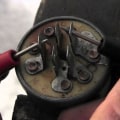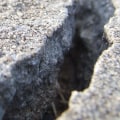The recommended thickness of a concrete layer should be between 1 and 2 inches. Some people will even reach a thickness of ¼ inch, which is still sufficient according to their needs. The maximum thickness in some cases can be up to 2 inches thick. Often, they also have a broom finish, are left smooth or stamped, depending on the preferences of the owner of the house who is starting the improvement.
Thin overlays are typically classified as those that are ¼ inch thick or less. The first step in installing these overlays is to prepare the tile that will be laid under it. The purpose of the preparation is to ensure that the surface does not contain any materials that can inhibit the joint, and you will have to prepare for profiling at a certain depth according to the thickness of the concrete layer you plan to use. The concrete layer is not breathable, and any moisture vapor from below will lift it off the slab and cause cracks.
Many variables can come into this, from the actual quality of the material in general, the amount of preparation done and the amount of regular maintenance it receives, all contribute to the impact of how the life of a concrete screed can be extended. According to the American Concrete Institute, high temperatures, coupled with low humidity and strong winds, will cause water in the concrete to evaporate during curing, leaving the overlay vulnerable to shrinkage and cracking even before the concrete sets. The covering material can be a simple sand-cement mixture or, in reality, it can be a real concrete mix that includes small pieces of stone or even large stones, depending on the thickness of the layer. Thin concrete overlays are rapidly growing in popularity due to their ability to solve problems with existing concrete and add a beautiful finish.
The concrete screed itself is composed of materials that are known to be quite resistant to most damage, from etching to staining, heavy equipment use, spillage, etc. Just keep in mind that the thicker the concrete layer, the more you need to reinforce it, the welded wire cloth to give the concrete something to adhere to and that will be maintained accordingly. Concrete cannot be poured onto old asphalt or other non-concrete surfaces because these materials will react with the water in the concrete, causing the mixture to become too soft for further processing. In its simplest form, a concrete screed is a thin layer of concrete applied over an existing concrete slab.
The advantage of patterned concrete coatings is their ability to mimic other materials without replacing concrete. For an experienced group of certified concrete coating installers, contact Sundek, the leader in concrete repair and thin concrete resurfacing solutions. Even if you do not have an existing concrete slab as a subfloor, you can install a concrete screed on a subfloor or on any other floor of some other type. Thin layers of concrete can be made from a variety of materials, including wood, plastic, metal and rubber.
When installing thin concrete overlays, remember that preparing the sub-base is one of the most important steps. The type of reinforcement used in concrete also plays a role in determining how much concrete can be poured before you need reinforcing bars.







Leave Reply